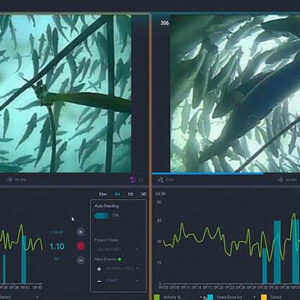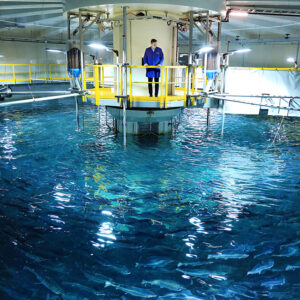
Just as it did with the enterprise of space a few years back, artificial intelligence (AI)-driven solutions are creating quite a buzz in land-based aquaculture space. Is it time for your company to jump on the AI bandwagon?
What is AI?
In simple terms, AI is a field of computer science which focuses on computer software that is able to mimic the way humans perform complex tasks such as learning, analyzing, and solving complex problems.
Some general real-world examples of the use of AI include video streaming services that provide movie recommendations based on films you’ve watched previously; automated spam filters; and bank programs that can detect potentially fraudulent activities.
Artificial intelligence is often used with or interchanged with the term machine learning (ML). However, ML is a branch of AI. Machine learning focuses on the use of data and algorithms to imitate the way humans learn to allow technology solutions to improve their accuracy.
Think of machine learning as one of the methods used by AI to accomplish its task. Robotics is another subset of AI. In robotics, the focus is using computer science and engineering to create machines capable of learning and performing complex tasks.


Risk and rewards
Many of today’s AI solutions have the potential to help you cut cost and boost productivity, according to Brian Jackson, research director for the chief information officer (CIO) space of Toronto-based company Info-Tech Research Group. However, as with any other business tool, it’s best to look before you leap, according to Jackson.
“Asking what AI tool you should purchase is like putting the cart before the horse,” says Jackson. “As with any technology project, you need to start with questions like: What is the business problem we need to solve? How will this technology impact my operations? Will this make me more efficient? “
Training and ease of use is another issue. Before investing in an AI solution, operators should ensure that adequate training and support is available for the personnel that will be using the technology.
AI solutions rely on data inputs. Fish farmers should also be mindful of potential data risks when using cloud-based solutions. You could be putting proprietary data or information you don’t want competitors to know at risk when you use cloud-based tools warns Jackson. Operators need to make sure they understand what safeguards are being employed to protect their data.
Jackson also recommends that any technology implementation should have measurable results. “Make sure you get the metrics. Measure the results. That way, you can decide if you want to scale-up.”


Aquaculture applications
At the heart of AI solutions is its capacity for predictive modelling, according to Jackson.
Instead of relying on predefined equations or assumptions, AI models learn patterns from past data. They are able to make predictions or decisions without being explicitly programmed.
“The core of AI solutions has always been predicting,” says Jackson. “AI is undeniably good at predicting outcomes using information that is in front of it.”
There are a number of key areas where AI can help organizations whether they’re a conglomerate or a land-based fish farm.
In aquaculture, predictive analytics is now being used to monitor fish behaviour, diagnose diseases, estimate biomass, determine feed conversion ratio, monitor fish volume and stocking density, measure water quality, and forecast events.
“Generally speaking, AI solutions can help boost economic performance, increase productivity, cut production cost, aid in reducing environmental footprint, and even assist in security measures,” says Jesse Ronquillo, an aquaculture scientist and who is an adjunct professor at the Dalhousie University and teaches in the aquaculture program of North Island College in British Columbia.
“For example, consistent aeration to oxygenate water in the culture system helps the fish to breathe, survive, grow, and reproduce. AI can help you monitor, manage, and maintain the oxygen levels in the water.”
Ronquillo says AI solutions for aquaculture purposes are often found in the following areas:
- Remote monitoring – AI enables fish farmers to remotely monitor and maintain facilities. These AI driven tools can alert farmers of things such as power outages, water temperature, oxygen levels, fluctuations in pH, nitrite, ammonia, and alkalinity levels. An example of such tools would be Innovasea’s aquaEnvironment platform uses unwater sensors uses sound waves to wirelessly report on variables such as water temperature, salinity, and dissolved oxygen. The European Union funded project called SHOAL actually uses a robotic fish equipped with onboard sensors that measure salinity and detects pollutants in the water it swims through.
- Feeding and growth statistics – There are a number of AI-powered solutions designed to help fish farm operators measure statistics around feeding and fish growth. These tools are designed to minimize food wastage, optimize consumption, and help farmers fine-tune growth and survival strategies.
- Tokyo-based Umitron has a plug-and-play AI tool called Remora that uses real-time monitoring of the swimming behaviour of fish to determine how much feed should be released. The system also allows operators to remotely release the feed without having to visit the site.
- The AKVA Group has recently bought a stake in Observe Technologies. Observe Technologies has an ASI tool keeps track of measurable patterns in fish movement to determine deviations and abnormalities. This allows the software to determine when to minimize or increase feeding.
- XpertSea takes the guesswork out of deciding when the best time is to harvest shrimp. The company’s GrowthPlatform tool uses computer vision and AI to calculate the growth of shrimp. It uses AI techniques such as deep learning to predict the most profitable harvest periods. The software is continuously learning. It collects historical data on growth cycle to provide more accurate predictions. GrowthPlatform has an online management software that provides fish farms actionable insights throughout the production cycle.
- The BiomassPro from Innovasea is an AI-driven camera that is able to estimate fish size and weight in real time. The tool can provide accurate growth projections and improve resource planning and sales forecasting. BiomassPro is available for six species: Atlantic salmon, cobia, Chinook, red snapper, totoaba and yellowtail kingfish.
- Disease detection – Artificial intelligence methods can also be used to annotate data and present them in a way that predict potential disease outbreaks. Norway’s Seafood Innovation Cluster launched its cloud-based platform AquaCloud in 2017. AquaCloud uses IBM AI platform Watson in detecting and predicting lice development in water so that infestation can be dealt with earlier. This reduces the dependence in expensive medical treatments.
- The Indian company Aquaconnect developed FarmMOJO. The mobile application records production data such as water quality parameters, biomass conversion and health status to alert shrimp farms of conditions that could be signs of disease occurrences.
The increasing use of AI in land-based aquaculture will allow operators to focus on other tasks such as strategic planning, says Ronquillo. He foresees an increasing use of AI as these tools become more powerful.
“The use of AI in aquaculture negates the need for fish farmers to manually perform tedious activities for long hours,” says Ronquillo. “Predictive analytics is also paving the way for aquaculture practitioners to obtain actionable insights to strategize their upcoming actions.”
Print this page
